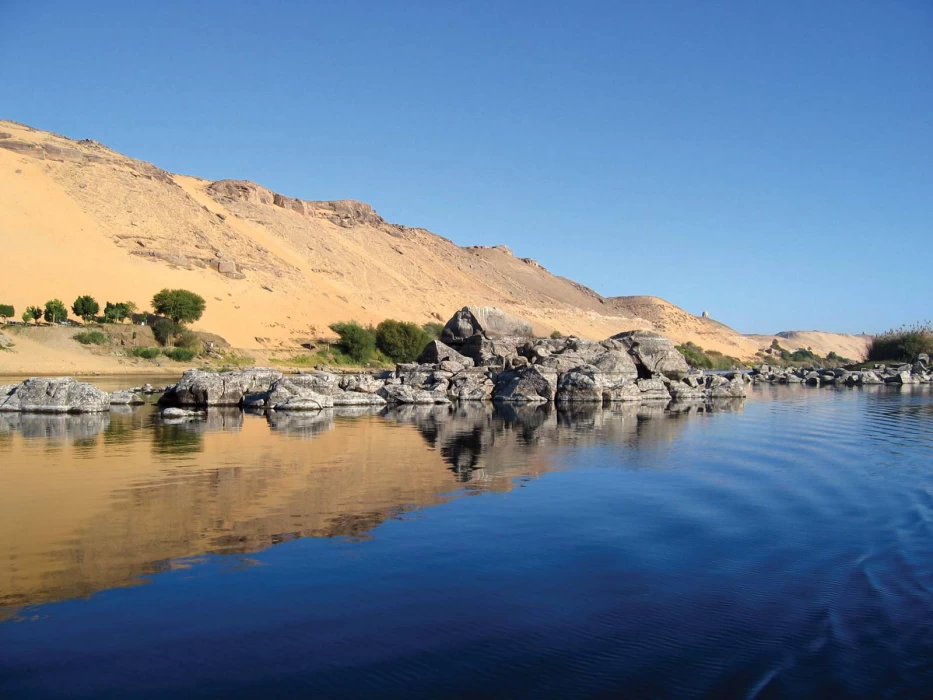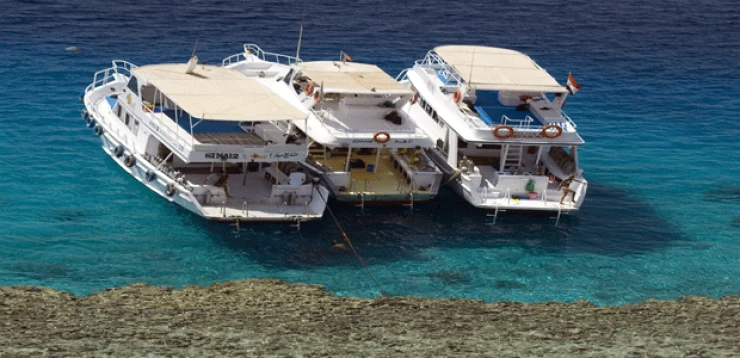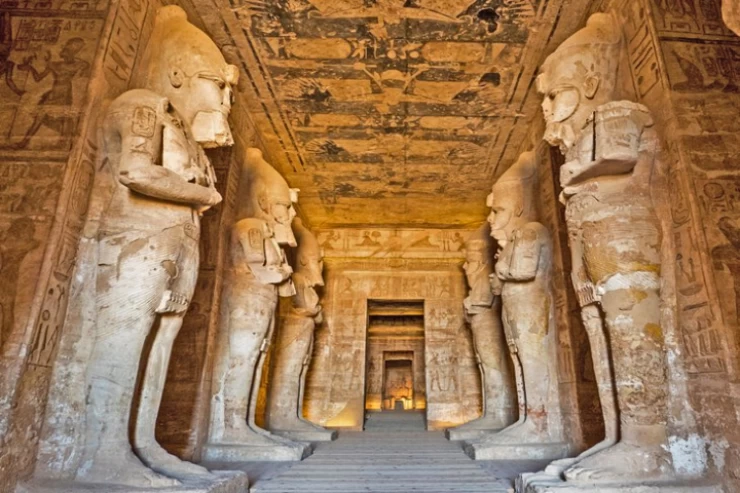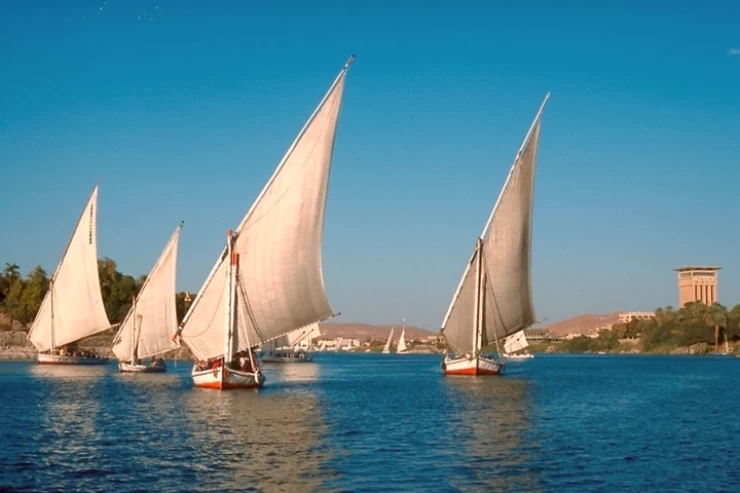
El rio Nilo
El río Nilo es el río más largo del mundo, que se extiende por 6853 km en el noreste de África. La palabra "Nilo" se deriva de dos palabras, "Neilos", una palabra griega que significa Valle, y la palabra latina "Nilo". El río Nilo es la vía fluvial que une los países de la Cuenca del Nilo que cubre 11 países africanos: "Uganda, Eritrea, Ruanda, la República Democrática del Congo, Tanzania, Burundi, Kenia, Etiopía, Sudán del Sur, Sudán y Egipto" . El Nilo es la principal fuente de agua en todos estos países y su agua se bombea desde dos afluentes, el Nilo Blanco, la corriente principal que comienza en los Grandes Lagos en África Central y el Nilo Azul, la fuente principal del noventa por ciento del agua y limo que fluye en el lago Tana en Etiopía y los dos ríos se unen en el norte de Jartum, la capital de Sudán. Sin embargo, el lago Victoria todavía se considera como la fuente más esencial del río Nilo.
El Nilo en Egipto se extiende desde los límites norteños del lago Nasser en Asuán hasta el norte de El Cairo, donde el Nilo se divide para formar el Delta del Nilo en dos ramas :
En la antigüedad, los egipcios primitivos se asentaron a lo largo de las orillas del río Nilo, donde construyeron casas y cabañas simples para alojamiento, cultivaron muchos cultivos y domesticaron algunos animales y desde entonces comenzaron los primeros pasos hacia la gloria egipcia. El cultivo fue el punto de partida cuando el río Nilo se desbordó, llevando depósitos de limo que cubrieron las tierras vecinas a lo largo del valle del Nilo y los hicieron fértiles. El trigo fue la primera cosecha, cultivaron los antiguos egipcios, dependientes de las inundaciones del Nilo como solución a la amenaza de hambre y falta de alimentos en ese momento. Por otro lado, utilizaron algunos animales como búfalos de agua y camellos para comer, arar y transportar mercancías. En resumen, el río Nilo es esencial para las personas, los cultivos y el ganado. Poco a poco, la mayoría de los egipcios se mudaron al Valle del Nilo, donde podían obtener su sustento. Cuando los Ancestros se unieron en las orillas del Nilo, produjeron la antigua civilización egipcia, una de las civilizaciones más grandes de la historia antigua que fue testigo de la construcción de muchos templos y tumbas con tesoros preciosos y joyas. El efecto del río Nilo se extiende a Sudán, donde contribuyó significativamente a erigir los reinos sudaneses.
Como parte de los intereses de la vida religiosa de los antiguos faraones y su insistencia en crear muchos dioses y diosas para los elementos físicos, honraron al río Nilo creando a Sobek "Dios del Nilo" o se lo llamó "Dios del Cocodrilo". Dios de un hombre con cabeza de cocodrilo representaba la fertilidad, los humedales, la medicina y la muerte súbita, y se considera que el río Nilo es el sudor de Sobek. Otro dios relacionado con el Nilo en el antiguo Egipto es "feliz", se llama "Señor del río trayendo vegetación" o "Señor de los peces y las aves de los pantanos", el dios de las inundaciones anuales del Nilo, que controlaban en gran medida el nivel del agua, simboliza la fertilidad. Los desbordamientos llevaron limo rico a las tierras del valle del Nilo para cultivar. Otro papel que jugó el Nilo en la vida del antiguo Egipto es dividir el calendario antiguo en tres estaciones, cada una de cuatro meses, "Akhet" representa la temporada de inundación cuando el Nilo se desbordó, Peret es la estación de crecimiento cuando el suelo es fértil por el Nilo. limo, y Shemu simboliza la temporada de cosecha en los momentos de sequía.
Puede viajar a Egipto y navegar por el río Nilo a bordo del crucero por el río Nilo y el crucero por el lago Nasser, Cairo Top Tours ofrece las mejores ofertas y ofertas para Egypt Classic Tours, tours privados en El Cairo, paquetes de viajes a Egipto, excursiones de un día a Egipto, día a El Cairo tours y excursiones de un día a El Cairo desde el aeropuerto para satisfacer los deseos de los viajeros sobre los lugares históricos y los diversos museos en Egipto, los representantes de Cairo Top Tours lo ayudarán durante sus paquetes clásicos a Egipto y cubrirán la mayor parte de la tierra de los faraones. Reserve ahora para una gran experiencia de vacaciones en Egipto y paquetes de vacaciones en Egipto y recorridos por Egipto y experimente la experiencia de reservar paseos en Felucca en El Cairo y recorrer Egipto. En Cairo Top Tours no escatimamos esfuerzos para ofrecerle lo mejor de nuestros tours y excursiones en Egipto.
Disregarding its claim to being the longest river in the world, the Nile epitomizes all that is Egypt in terms of geography, history, and culture. The Nile is located in the northeastern region of Africa and is about 6,650 kilometers long (4,130 miles), running through 11 different countries before emptying into the Mediterranean Sea. Nevertheless, the most well-known portion of the river is certainly in the country of Egypt, where not only has the river formed the present-day geography of the place but also sustained one of the most ancient and greatest civilizations in the world. It is often referred to as the ‘Gift of the Nile’. Most of the wealth, progress, and history of Egypt have revolved around this river.
Egypt boasts of long stretches of deserts, but it is interesting to note that the Nile River has succeeded in forming a vegetative zone in the region otherwise characterized by dry lands. Without the Nile River, the majority of regions within this nation’s borders would more likely than not be empty and unproductive land. It supplies water, which is sourced for farming, business, and even household use. In ancient times, the Nile used to spill over its banks, and every year the lands along the river, such as the region around the Nile, received rich alluvial deposits that were excellent for farming. These floodwaters every year without fail were perfect for growing crops for the ancient Egyptians, who grew different crops such as wheat, barley, and flax, which were the main food and agricultural income of this community.
Today, while the Aswan Dam was built in 1970, which led to the complete control of tree flooding and therefore the abolition of the age-old flood regime, the Nile River is still of great importance for agriculture in Egypt. Filmy green container siding strips that fit perfectly along the banks of the river, which is reminiscent of the shape of the river, sharply contrast with the yellow sand canvas of the desert, indicating that the Nile River is of key importance to the people of Egypt.
The Nile was an important resource for agriculture, but its relevance does not end there; much of today’s world owes its existence to Egypt as we know it. Civilizations flourished on both banks of the ancient Nile as it provided not just water and rich alluvial plains, but also integrated the two banks using transport and communication. The river was crisscrossed by boats transporting goods, people, and ideas, effectively bridging the gap between Upper and Lower Egypt and emerging as one of the most powerful kingdoms.
Furthermore, the river found its place also in the divine and cultural aspects of the ancient Egyptians. The floods of the river, which were very important for agriculture, were treated in ancient times as a curse from Hapi, the protective god of the fertile Delta and the Nile. The river was also linked with the idea of death and what came after it. The Egyptians believed that the east side of the Nile River where the sun rose was the region of the living, while the west side where sunset occurred was the realm of the dead. This explains why some of the country’s most popular structures, including the Great Pyramids and the tombs in the Valley of Kings, are located on the western bank of the river.
The legacy of the Nile is inscribed in the very topography of the nation of Egypt, with nearly all its iconic representations located along the banks of the river. In Cairo, for instance, west of the Nile runs the Giza Plateau, which houses the Great Pyramid among other pyramids, and the infamous Sphinx that has stood for more than 4500 years. The stones used to create these buildings rose from within the depths of the Nile and were transported therein, thus revealing the contribution of the river towards the architectural peculiarity of Egypt.
Going further down south to Luxor, yet another ancient hub, the Nile cuts across it. East Bank consists of the vast temples of Karnak and Luxor, which were the places of worship for the exalted pharaohs. West Bank is characterized by the flat surface of the Valley of the Kings, which hosts the burial places of the most powerful kings’ in Egyptian history, with the famous King Tut’s tomb being one of them. It was the Nile that linked those cities and the temples, and the Nile waters flowed in bringing the resources necessary for erecting such remarkable edifices.
One of the striking cases of the power of the Nile on Egyptian monuments might be the temples of Abu Simbel, which are found on the southern border of Egypt close to Sudan. Colossal temples were carved by the mountain by Ramses II, and since they are located close to the river, there was a risk when the Aswan High Dam was being built. In an astonishing engineering accomplishment, the temples were moved to a higher location to protect them from the adverse effects of the water levels of Lake Nasser, an enormous reservoir that was built because of the dam. At this point, they are both an ancient and contemporary reminder of the connection that Egypt has with the Nile.
The Nile is still an integral aspect of modern-day Egypt. The river is still used for irrigation and even provides drinking and industrial water. It has also maintained its relevance as a waterway, and especially as a tourism-based route. Cruises on the Nile between Luxor and Aswan allow tourists to experience the beauty of the river and, along the way, some of the exotic historic sites of Egypt. This pace of the river sets the mood for temple, tomb, and village raids, which are fun-beholding sights of historical Egypt.
The Nile has been a major factor in the growth of cities like Cairo, Aswan, and Luxor. In Cairo, the Nile passes through the very middle of the populated city, providing a serene gate away from the noisy road. Corniche El Nile, which is a wall fronting the river in the city, is frequented by people, both locals and tourists, who go there to see the river, and particularly sunsets are breathtaking. Calm sailing wooden boats called feluccas move on top of the river, recalling the magic of the serene Nile.
Aswan is characterized by the majestic flow of the Nile that meanders, surrounded by patches of granite and tiny islands, providing an ideal ambiance to learn about the Nubian culture and Philae Temple. The slower-paced atmosphere created by the clear waters in Aswan makes it one of the most captivating places along the Nile, where visitors feel relaxed as if everything is flowing with the river at a gentle pace.


















